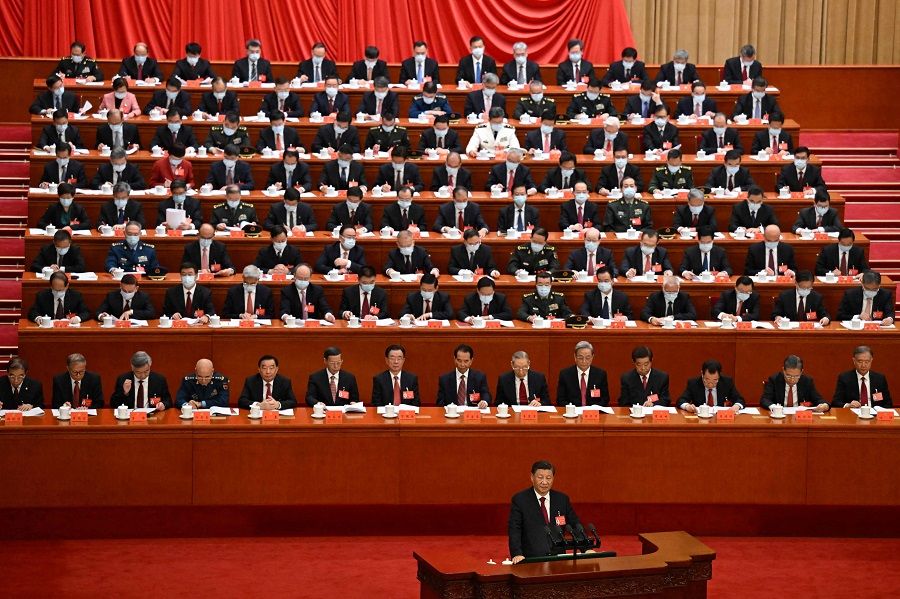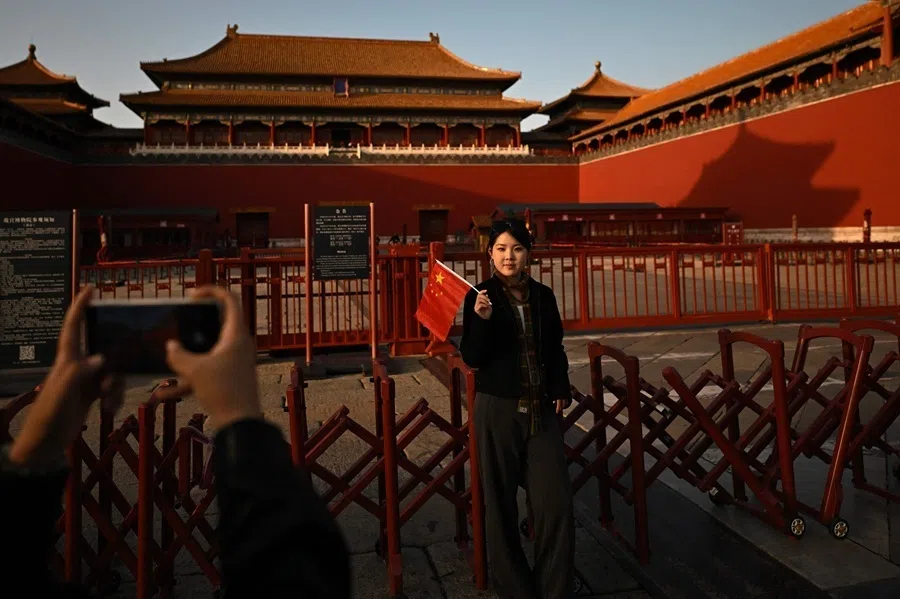China’s Communist Party faces tall order at third plenum
While rebuilding the Leninist model enjoys strong party support and legitimacy, the Chinese Communist Party must confront various issues and challenges amid national and global contexts and current trends. Failing to address these issues could hinder China’s emergence and national rejuvenation, says EAI senior research fellow Lance Gore.

The Third Plenum of the 20th Central Committee of the Chinese Communist Party (CCP) is set to convene on 15 July, at least eight months later than usual. The delay has been rare since the time of China’s reforms and opening up, inviting speculations domestically and internationally. This article explores the announced theme of the meeting to “primarily examine issues related to further comprehensively deepening reform and advancing Chinese modernisation”.
Defining ‘Chinese modernisation’
“Comprehensively deepening reform” has been the major focus of the fifth generation of the CCP leadership. The Central Leading Group for Comprehensively Deepening Reform was established in November 2013 and upgraded as the Central Commission for Comprehensively Deepening Reform in March 2018.
Averaging one meeting a month, it would have held 126 meetings and approved thousands of reform measures, programmes, plans and decisions during its existence in the past ten and a half years. Why is there a need “to further comprehensively deepen reform” now?
The re-introduction of this term [“Chinese modernisation”] means that it now either has new meanings or a more systematic summary that forms a new theoretical framework.
A basic view is that the main focus of the CCP since 2013 is to restore the Leninist model of governance, which involves the centralised unified leadership of the vanguard party. A key feature of this model is its reliance on ideology.
The supreme leader’s “integrity and innovation” in ideology have been the reasons for the party adapting to new situations without losing its foothold or vibrancy. Mikhail Gorbachev sacrificed ideology for innovation and abandoned Marxist ideals, which led to the demise of the Soviet Union.
The proposed emphasis to “further comprehensively deepen reform” is related to “Chinese modernisation”, which has been articulated and summarised at the CCP’s 20th Party Congress. The re-introduction of this term means that it now either has new meanings or a more systematic summary that forms a new theoretical framework. It appears that ideology is an important item on the agenda of the upcoming Third Plenum.
Finding China’s new vision
The exploration and innovation in ideology have been an ongoing process, from Xi Jinping’s series of speeches after the 18th CCP National Congress to the official proposal of “Xi Jinping Thought on Socialism with Chinese Characteristics for a New Era”, which was further elaborated and refined at the CCP’s 20th Party Congress.
The Third Plenum will be a continuation of this lengthy process that is constantly adapting to circumstances. It started with the resolute return to Marxist orthodoxy in establishing ideals and beliefs, and progressed to the significant integration of traditional Chinese culture in an effort to align Marxism with the theme of the rejuvenation of the Chinese nation. The concepts of “Chinese modernisation” and the related “new quality productive forces” are the latest developments.
One objective of rebuilding ideology is also to seek a new direction for China and humanity, formulate a blueprint for the future and for China to make new and long-awaited contributions to the world...
There is a grand vision behind all this.
After decades of “crossing the river by feeling the stones”, there are many successful experiences to encapsulate as well as many accumulated problems, including corruption, the decline of the central authority, emergent interest groups, slackening party discipline, and the polarisation of the rich and the poor. Anti-corruption measures and party building aim to address these issues.
One objective of rebuilding ideology is also to seek a new direction for China and humanity, formulate a blueprint for the future and for China to make new and long-awaited contributions to the world, in the face of “global changes of a magnitude not seen in a century”.
This ambition is not unfounded, considering China’s twin miracles of rapid economic growth and long-term social stability. In contrast, the West lacks direction due to sluggish growth, frequent financial crises, social schism and political extremism and intractable problems such as ageing infrastructure, deteriorating public security, debt, racial and religious conflicts, and social ills such as drugs, violence, poverty, hunger and homelessness. Xi has remarked, quoting a line from Mao’s poem: “The scenery is beautiful only on our side”.

It would be significantly advantageous to China in both the domestic and global contexts, if it could promptly rectify its ills, formulate an effective system to “achieve unity in thinking, will, and action” and continuously advance towards the set goals through appropriate policies and strong leadership. This will enable China to successfully navigate these tumultuous times and accomplish its goals.
The basic assumption of the Leninist model for the party is that the party members are advanced. In this model, the party is made up of enlightened communists who possess firm beliefs, loyalty to the party, robust discipline, upright morals and ethics, and who are role models to the people. Mao Zedong said that “the power of example is infinite”. In the Leninist tradition, the party constantly overcomes difficulties, advances towards set goals and ultimately achieves the communist ideals.
However, the party has different tasks in different times, requiring different thinking in guidance. Hence, we have witnessed Lenin’s theories of imperialism and socialist revolution in one country first, Joseph Stalin’s planned economy, Mao’s continuous revolution under the dictatorship of the proletariat, and Deng Xiaoping’s reforms, opening up to the world, and socialism with Chinese characteristics, which has now entered the new era of Xi Jinping Thought. “One Ideology, One Party and One Leader” characterises the Leninist party.
The decentralised material interests comprehensively eroded the Leninist party...
Corruption and erosion of the leninist party
US political scientist Samuel Huntington believed that the vanguard party is the most successful form for a political party, especially during turbulent times in societies undergoing transformation. This is proven in the history of the CCP.
Under Mao’s leadership, the CCP overcame innumerable difficulties to defeat powerful opponents and seize power, resulting in the complete reversal of China’s poverty, weakness and disunity, as well as altered the nation’s spirit and successfully transformed China from an agricultural nation to an industrialised one.
Deng led the party in the nation’s reforms and opening up to the world, accomplishing successful economic development to make China the world’s second largest economy. Deng was very confident that with the CCP leadership, there was nothing to fear, and that there was no need to worry about capitalist resurgence in a market economy.
Indeed, this powerful core leadership that has consistently delivered results during these periods is rarely seen in other nations. Leninism, after all, means an advanced political party leading a nation to advance successfully into the future.
However, the challenges for the market economy are fundamentally different from those during the times of armed revolution and the planned economy. The decentralised material interests comprehensively eroded the Leninist party, including its ideological belief, the authority of the Central authority, party discipline, party members as role models, the value system and the attitudes towards power.
These altered beyond recognition, greatly deviating from the party’s original mission to the extent that corruption has reached a state which, if checked, will doom the party, and if unchecked, will doom the nation. The advantages of the party in the Leninist tradition had instead turned into advantages in corruption and rent-seeking. Xi began his party rectification under these circumstances.
Xi’s resolution
First, the centralised power and implemented anti-corruption measures to establish authority and win popular support, with intensity unprecedented since China’s reform and opening up. Next, he tried to purge the influence of Western liberalism, restored the Marxist beliefs, and quipped, “Revolutionary ideals are loftier than the sky,” attributing the Soviet Union’s demise and widespread corruption in the CCP to the loss of ideological faith.
This is followed by large-scale improvements to discipline, organisation and systems, and above all, to achieve unity in thinking, will and action, under his newly formulated ideology — Xi Jinping Thought.
This is an ambitious and complex undertaking, for which no other person within the CCP possesses the vision, drive and perseverance. This is an important reason why Xi remains unchallenged within the party.

This is an ambitious and complex undertaking, for which no other person within the CCP possesses the vision, drive and perseverance. This is an important reason why Xi remains unchallenged within the party.
However, although rebuilding the Leninist model appears logical and has strong support and legitimacy within the party, it faces a series of issues and challenges in alignment with the national and global contexts as well as world trends. The failure to address these issues and challenges would thwart China’s emergence and the rejuvenation of the Chinese nation.
Can the four major challenges be overcome?
Contradiction with market economy
First, this political rebuilding fundamentally contradicts China’s market economy in that one emphasises control while the other, liberalisation.
The party in the Leninist tradition is one of centralism, not democracy. The closest to the ideal democratic centralism that the CCP came to was during the Yan’an period, when Mao’s vision then was a political situation with “both centralism and democracy, both discipline and freedom, both unity of will and personal ease of mind and liveliness”, which continues to appeal to the CCP.
Yet, experience has shown that an equilibrium does not exist between democracy and centralism, and therefore democratic centralism is unsustainable.
In the long run, a theoretical foundation of market economy must be created within Marxist theoretical edifice, otherwise the market economy will always be in a precarious state. The party’s centralised and unified leadership is both an institutional advantage and the reason for its inability to truly adapt to the market economy.
Totalitarianism, which is total control and micro-rule, is a perpetual tendency in the vanguard party. Market-oriented reforms challenge this model but the emphasis on party leadership brings back totalitarianism, such as the “total coverage” of party organisations, which are required to be set up within all non-party organisations, including private enterprises and foreign businesses and even Buddhist temples.
... the new technological revolution not only challenges dialectical materialism but also reveals with increasing clarity, the flaws in the Marxist theoretical framework.
Flaws in Marxist theoretical framework
Second, there are theoretical difficulties because the new technological revolution not only challenges dialectical materialism but also reveals with increasing clarity, the flaws in the Marxist theoretical framework. Today, the future of humanity is uncertain, let alone that of the proletariat — will the purely biological human still exist in a few decades? Karl Marx did not foresee the continued vibrancy of capitalism today and the middle class revolution.
In addition, the converse of proletarian dictatorship has taken place. High-calibre party cadres have fallen to become a privileged class that oppresses the people and will ultimately be rejected by the people. This cannot be explained away as the “loss of ideological faith”; instead, it is the inevitable outcome of the system and power structure.
Holding the “noble ideal of communism” as the destiny of “global changes of a magnitude not seen in a century” is unlikely to convince many, including the majority of the CCP members.
From a practical perspective, concepts such as the abolition of private property and exploitation, proletarian dictatorship, class struggle and the labour theory of value are core concepts of Marxism. But they are in conflict with the demands of the market economy, causing private entrepreneurs and high-net-worth individuals to feel insecure and yearn to emigrate, regardless of how many laws are passed to protect private property. These problems will inevitably resurface even if they are swept under the carpet.

Stiffling innovative vibrancy
Third, the crux to succeed in the era of new technological revolution is innovative vibrancy. The Leninist party model is characterised and epitomised by the Chinese term zhua (roughly “seizing control”, 抓), which is ubiquitous in party documents, reports, directives, propaganda and speeches. The lateral logic of the market struggles to unfold under the vertical “control” of the party-state.
The emphasis on “control” leaves little room for autonomy down the hierarchy needed for innovation and vibrancy. Related to this are prevalent official behaviours, such as the fear of speaking up and telling the truth, passivity and inaction, as well as “formalism” and “bureaucratism” constantly assailed in the official media.
This system is not designed to encourage innovations, and in extreme circumstances such as during the Cultural Revolution, the freedom of thinking and imagination only exists at the top.
Furthermore, to shore up the supreme authority, party members and cadres are prohibited from critically discussing the decisions and policies of central authority”, amid endless repetitions of the “Four Consciousness” and “Two Upholds”.
This system is not designed to encourage innovations, and in extreme circumstances such as during the Cultural Revolution, the freedom of thinking and imagination only exists at the top. Establishing a pervasive mechanism for innovation is a huge challenge for further comprehensive deepening of reforms.
When power corrupts
Fourth, corruption remains unresolved. The number of recent corruption cases, the level of officials involved, the amounts of funds and the nature of these cases are almost unchanged from ten years ago, indicating that top-down anti-corruption efforts are ineffective. As power and corruption are inherently linked, the real issue that must be addressed is power, and not corruption alone.
Is there room within the Leninist tradition to address these challenges, or is a paradigm shift required? If so, the paradigm shift must entail innovation and not merely embrace liberalism. While the magnitude of the innovation required may be beyond the current leadership, there is hope in the long run.





